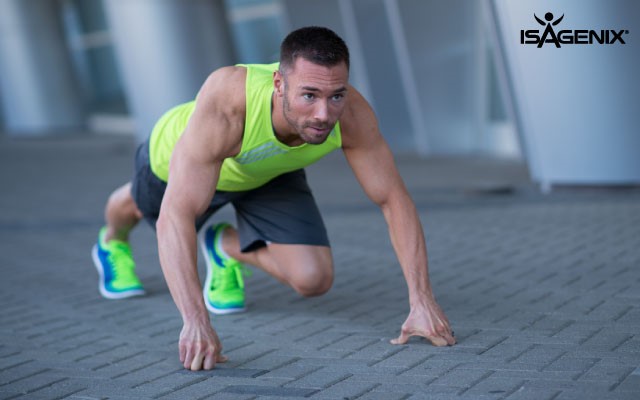While there’s little doubt that a person can be successful with an Isagenix weight loss system alone – as is documented in clinical studies (1-3) – the fact remains that exercise as an added component to your system will make your results more profound.
Here are three reasons for why an exercise regimen can improve your results with Isagenix:
Reason #1: Strengthen Muscles and Bones
Without exercise, a percentage of your weight loss can be from muscle and bone density. In fact, studies on weight loss without exercise predict that about 25 percent of weight loss can be from lean body mass tissues including from bone and muscle (4).
Getting enough quality protein and nutrients from Isagenix daily certainly helps with maintaining lean body mass. But ultimately it’s exercise that stimulates lean mass preservation – through muscle protein synthesis and bone remodeling – ensuring that you’re improving your health status.
Reason #2: Burn More Body Fat
Through preservation of lean body mass, you’re more likely to burn more body fat. If the number on the scale isn’t moving as quickly as before, just remember that muscle takes up much less space than fat does. Instead, focus on how your clothes fit and take measurements.
Having a bit more muscle is also good for your metabolism. Remember that muscle contributes to your resting energy expenditure and represents 60-70 percent of your total daily metabolism (5). Muscle is also much more metabolically active compared to body fat, meaning it needs more energy just to carry out its normal processes.
Reason #3: Improve Body Composition
In a recent pooled analysis of 66 population-based studies, a clear pattern was established when exercise was included as part of weight loss (6). Exercise, in combination with weight loss, not only improved metabolism, but also body composition.
The effectiveness of exercise was even more pronounced when it was included in the form of higher-intensity exercise with resistance training. Moreover, a higher protein intake in combination with resistance training outperformed all other diet options examined. In short, the subjects lost more total body fat while retaining lean body mass.
Exercise 30 Minutes Daily at Minimum
For weight loss and prevention of weight regain, the American College of Sports Medicine recommends moderate intensity physical activity between 150 and 250 minutes a week, or roughly half an hour a day (7).
It’s a small investment. Engaging in some form of exercise may help you reap maximum benefits from Isagenix products.
References
- Klempel MC, Kroeger, CM, Bhutani S et al. Intermittent fasting combined with calorie restriction is effective for weight loss and cardio-protection in obese women. Nutr J. 2012 Nov 21; 11:98.
- Kroeger CM, Klempel MC, Bhutani S et al. Improvement in coronary heart disease risk factors during an intermittent fasting/calorie restriction regimen: Relationship to adipokine modulations. Nutr Metab. 2012 Oct 31; 9(1):98.
- Arciero PJ, Edmonds R, He F et al. Protein-pacing caloric-restriction enhances body composition similarly in obese men and women during weight Loss and sustains efficacy during long-term weight maintenance. Nutrients. 2016 Jul 30; 8(8).
- Weinheimer EM, Sands LP & Campbell WW. A systematic review of the separate and combined effects of energy restriction and exercise on fat-free mass in middle-aged and older adults: implications for sarcopenic obesity. Nutr Rev. 2010 Jul; 68(7):375-88.
- Ravussin E, Lillioja S, Anderson TE et al. Methods and results using a respiratory chamber. J Clin Invest. 1986 Dec; 78(6):1568-78.
- Clark JE. Diet, exercise or diet with exercise: comparing the effectiveness of treatment options for weight-loss and changes in fitness for adults (18-65 years old) who are overfat, or obese; systematic review and meta-analysis. J Diabetes Metab Disord. 2015 Apr 17; 14:31.
- Donnelly JE, Blair SN, Jakicic JM et al. American College of Sports Medicine Position Stand. Appropriate physical activity intervention strategies for weight loss and prevention of weight regain for adults. Med Sci Sports Exerc. 2009 Feb; 41(2):459-71.





